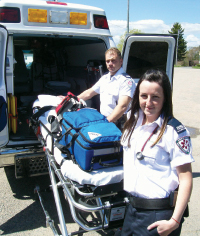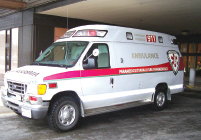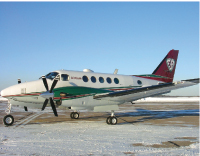
Headlines
News
Banding together: New Brunswick consolidates ambulance service
The province of New Brunswick, with a population of about 750,000, has adopted a new model for the delivery of ambulance services.
June 5, 2008
By Andrew A. Sanojca
The province of New Brunswick, with a population of about 750,000, has adopted a new model for the delivery of ambulance services. Ambulance NB (ANB), a newly formed public-sector company, has taken over all land-based ambulances and the air ambulance service. ANB is managed by New Brunswick EMS, a subsidiary of Medavie EMS. Medavie EMS has operated the provincial ambulance system in Nova Scotia for 10 years, and began operating a provincial system in Prince Edward Island last year.
Contracts for pre-hospital emergency care and patient transfers were previously held by 39 service providers, operating under more than 50 contracts. These providers included regional health authorities, municipalities, for-profit companies, non-profit organizations and First Nations communities.
 |
| TOP: Paramedics Pauline Heelan and Jeff Levesque with their first-in gear. BELOW: Ambulance New Brunswick, a new public- sector company managed by New Brunswick EMS, has taken over all land-based ambulances and air ambulances. PHOTOS BY ANDREW SANOJCA |
 |
The New Brunswick Department of Health announced the new service on June 12, 2007, settled the contracts with previous operators and all assets were turned over to ANB.
All qualified medics were offered employment with ANB and those who accepted the offer began working for ANB on Dec 16. The service includes 750 primary care paramedics operating up to 126 ambulances from 75 bases. There is a shortfall of about 100 medics, which has resulted in some shifts being covered by overtime. Some of this shortfall may be relieved when the current PCP students complete their courses. It is expected that there will be about 900 paramedics in the system by 2010 and the number of ambulances may increase to135.
When the change was announced, there was a mix of certification and skill levels among New Brunswick’s paramedics and ambulance staff. The majority were trained as emergency medical technicians while some were primary care paramedics. Most had training in advanced life skills.
A news release from the province said that in keeping with national standards, primary care paramedic (PCP) would become the basic entry level for all new paramedics working in New Brunswick. The government also intends to introduce advanced care paramedics.
The look of the ambulances has changed to white with burgundy and green stripes from white with an orange stripe. There is also a new ANB logo that includes a provincial galley boat over a star of life.
Managing all these resources and getting them to the right place at the right time is the responsibility of the Medical Communications Management Centre (MCMC) in Moncton. Dispatchers at the centre co-ordinate scheduled transfers and dispatch incoming 911 calls.
The goal of ANB is to provide standardized care to all residents in the heavily rural province. To do this, the system must make the best use of its available resources. While some services would previously sit idle for extended periods, under the new system, all resources are being used to provide emergency coverage and patient transfers. Provincial ambulances respond to 120,000 calls a year, of which 50 per cent are patient transfers between hospitals and nursing homes or back to a patient’s residence. Of the approximately 60,000 patient transfers completed, almost 40 per cent are long-distance transfers, where the patient is taken to another facility in a different community.
As with any major change, the new ambulance system has had some difficulties. Rock Marois, president and CEO of Ambulance NB, said the new deployment system has been a concern for some communities.
“They used to have a locally run system and they used to see their ambulance parked somewhere. Now it’s not as visible, so this is a huge change.”
However, what is not visible to the community is the fact that while the ambulance stationed in the community may be out on a call, or covering a call in a nearby area, ambulances from what used to be bordering coverage areas are moving toward the community to provide balanced coverage. This includes moving ambulances from rural areas towards busier urban areas, where they can respond in a reasonable time in either direction.
 |
| An Ambulance New Brunswick air ambulance featuring the company’s new logo. PHOTO BY ANDREW SANOJCA |
Members of Saint John’s city council have been in the news often since the change was announced and some have not endorsed the changes. Not only did the city lose local control of its ambulances, it also lost the ability to dispatch those ambulances, and some councillors fears there may be a delay in help reaching those in need. The city operates a Public Safety Answering Point, where incoming 911 calls are answered, and dispatches its own fire and police departments, as well as several neighbouring fire departments. It used to dispatch ambulances within the city and Kennebecasis Valley, but all ambulance calls are now forwarded to the Medical Communications Management Centre in Moncton. Rock explained said the purpose of MCMC is to make the best use of all resources but acknowledges that the move to dispatch from one central location was controversial.
“It’s impossible to have a provincial system without having a provincial communications centre to control all your resources,” he said. ”I firmly believe this is working really well now.”
Better control of those resources may also include keeping an out of town ambulance in a major centre to assist with a backlog of patient transfers. The preference is to keep a local crew available to respond to 911 calls, however MCMC can help guide out-of-town ambulances to a scene using a GPS-based automatic vehicle locator, which have been placed in all ambulances. Medics often help each other out, with locals providing directions to those from out of town.
Two or more ambulance crews may now complete long-distance patient transfers. Because the ambulances are now owned by one company, and have all been standardized, with the same equipment located in same location, crews may perform a “seat to seat” transfer. This means a crew leaving Bathurst might trade ambulances with a crew in Moncton that has just dropped off a patient and is returning to Saint John. This is now possible instead of having to drive the whole distance and then return to the base,” Marois said.
“That is something that could not be done before, because of the fragmented nature of the old system.
“It allows for the originating team to go back to their area sooner, it reduces fatigue, and it allows us to better manage overtime because on long-distance transfers it can be a challenge to get people back before the end of their shift.”
In addition to making better use of resources and having a standardized fleet of ambulances, the ambulances will be maintained at regular intervals at three fleet centres. An existing contract with Malley Industries in Dieppe N.B., provides ambulances to ANB on a four-year lease. The vehicles are maintained and serviced by NB EMS and are returned at the end of the four years. With the better use and rotation of these vehicles it is expected each will have travelled about 280,000 kilometres by the end of their leases. Previously, some returned vehicles had travelled more while others had travelled fewer kilometres.
By 2010, Ambulance NB will be required to have an ambulance at an emergency scene within nine minutes, 90 per cent of the time, in urban areas, and within 22 minutes, 90 per cent of the time in rural areas. These time frames are already being met in most cases, but will form an integral part of the performance based contract.
Print this page